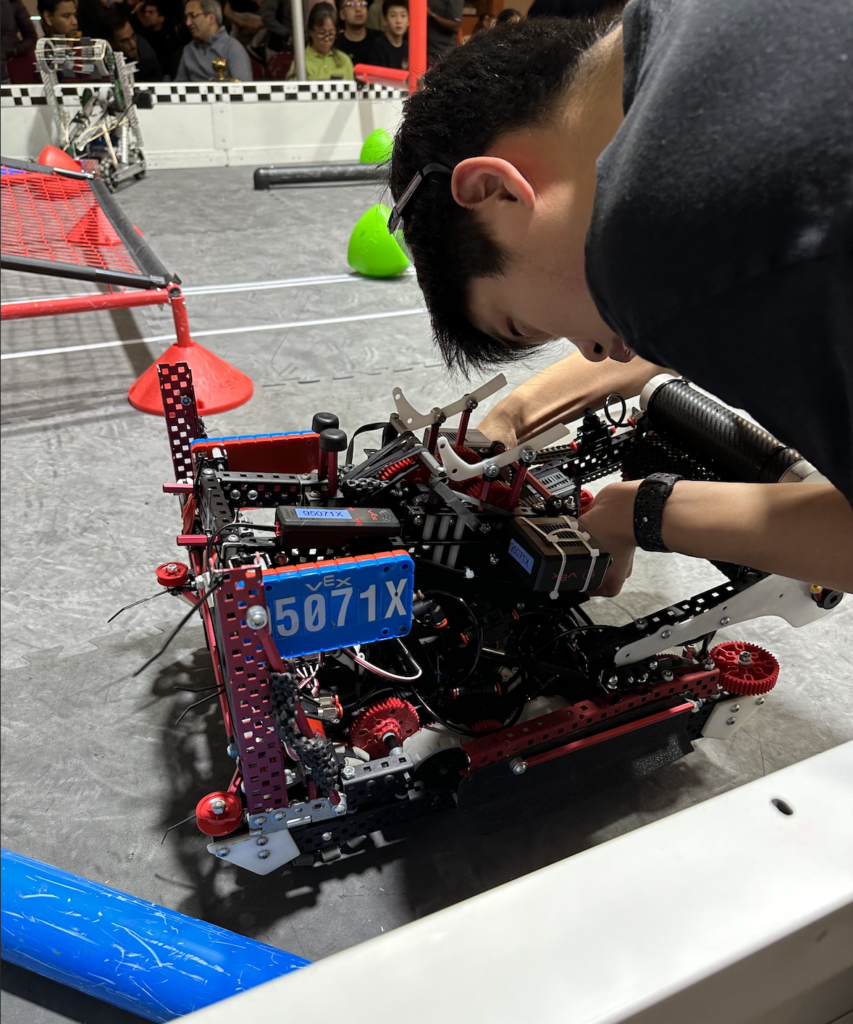Following an intensive winter break packed with multiple build and practice sessions, the school’s six VEX robotics teams are eager to put their robots to the test in upcoming competitions.
All teams have six members with two being team leads. Teams must win a regional competition or a noteworthy judge award at a regional competition to secure a spot in the state competition. From there, they can then compete to qualify for the world championship held from April 25-27 in Dallas. Teams 95071X, 95071V and 95071H have already qualified to compete in the state championship held on March 10 in Tracy. Meanwhile, teams 95071W, 95071Y, and 95071Z look to qualify in upcoming regional competitions like the Saratoga Falcons Annual Robotics Tournament held at the school’s large gym on Feb. 25.
This year’s game, “Over Under,” tasks teams with building robots capable of scoring acorn-shaped “triballs” into goals. During the final 10 seconds of a match, teams can elevate their robots via clamping to poles to gain extra points. Higher clamped robot heights equate to increased points.
Sophomore club secretary Richard Lee said team 95071X is nearing completion of a rebuild of their robot, which features improved maneuverability and clamp elevation.
95071X’s new build runs seven pounds lighter compared to its predecessor, thus lessening the strain on the pull-up clamp and, in turn, increasing the robot’s climbing elevation. In addition, the team fitted a faster drive train, which allows the robot to maneuver the field at higher speeds and increase the rate of scoring.
“Weight saving and speed were our main priorities; at this point, we’re just fine-tuning and we expect the build to be competition-ready in the coming weeks,” Lee said.
Lee added that the team employed a “parallel build strategy” to keep the old robot intact while constructing their new build as a safety precaution to ensure the team always had a functioning, competition-ready robot.
The six teams, with workspaces in rooms across campus, coordinate build strategies and share tips to maximize overall team results.
“Our H team is taking a similar approach to us [X team], so we share tips and stuff we learn through our trials and errors,” Lee said. “Generally, you’ll see radically different builds at the start of the season, but near the end, many builds converge in design and play philosophy.”
While team 95071X has made major build modifications given the two months they have until states, team 95071Z has directed their efforts toward training their drive team and enhancing their robot’s autonomous driving. Their goal is to maximize points in upcoming competitions to qualify for states.
“Launching the tri-balls onto the other side of the field is tricky, so it requires our drive team members to practice more since we want to do it as efficiently and effectively as possible,” 95071Z team lead sophomore Katherine Zeng said.
Zeng has also tasked her team with watching live streams of previous games to gain insights into strategy and gameplay. Ball control has been identified by the team as a make-or-break factor in elimination rounds, as most successful teams favored a slow but precise scoring technique rather than rapidly hoarding balls into goals with low accuracy.
Both Lee and Zeng are confident the club has ironed out growing pains from previous years, given its relative infancy of being founded in 2021.
Zeng emphasized the club’s doubling in size from 24 members to over 40 members and the presence of robotics veterans as key contributors to a hopeful season. Lee drew parallels between Saratoga and traditional VEX powerhouse teams such as Milpitas.
“We exist in a period sort of after Milpitas and Park Bots dominated the field, so I think we’re looking solid and on the come-up for states and worlds,” Lee said.


























